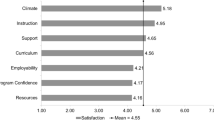Abstract
The Indian Institutes of Technology (IITs) are among the most prestigious technical institutes in India (and perhaps in the world) for undergraduate engineering education. Admission to an IIT is viewed by many Indians as a passport to success, prosperity, prestige, and possibly moving to Western countries for higher studies and/or jobs. This paper examines whether (i) access to the IITs is open to students irrespective of their socioeconomic status; (ii) students’ satisfaction, once they enter an IIT, is conditioned by their socioeconomic status; and (iii) students’ attitudes towards their future plans are influenced by their socioeconomic status. The paper is based on a survey conducted with nearly 260 students at two out of five original IITs in 2007–2008. Findings reveal that access to the IITs, satisfaction at the IITs, and future plans after the IITs are strongly correlated to students’ socioeconomic status. Even though admission to the IITs is based on an entrance examination, most of its students are from the socially and economically well-off families.
Similar content being viewed by others
References
Agarwal, P. (2007). Higher education in India: Growth, concerns and change agenda. Higher Education Quarterly, 61(2), 197–207.
Banerjee, R. & Muley, V. P. (2007). Engineering education in India. Mumbai: IIT Bombay.
Bhattacharya, A. (2006, April 8). Who are the OBCs? The Times of India.
Chaudhary, S. (2008, July 27). Problems inherent in creating new IITs. The Hindu.
Chhapia, H. (2008, August 3). Now IITs face shortage of students. The Times of India.
Chitnis, S. (2000). The challenge of access in Indian higher education. Liberal Education, 86(4), 10–17.
Dhoundial, S. (2008, June 14). IIT-Delhi sacks 12 SC/ST students, under probe. CNN-IBN.
Gaillard, J. (1991). Scientists in the third world. Lexington: Kentucky University Press.
Gill, S. S. (2006, April 13). What the Mandal Commission wanted. The Indian Express.
Gulhati, S. K. (2006). The IITs, slumping or soaring?. New Delhi: Macmillan.
IIT Bombay Heritage Fund. (2009). JEE 2009 results announced. Retrieved June 26, 2009, from http://www.iitbombay.org/news/Current/JEE-2009.
Kirpal, V., & Gupta, M. (1999). Equality through reservations. Jaipur: Rawat Publications.
Leslie, S. W., & Kargon, R. (2006). Exporting MIT: Science, technology, and nation-building in India and Iran. OSIRIS, 21(1), 110–130.
Menon, M. (2006, June 12). IIT students polarised on quota issue. The Hindu.
Murali, K. (2003). The IIT story: Issues and concerns. Frontline, 20(3). Retrieved March 8, 2008, from http://www.hinduonnet.com/fline/fl2003/stories/20030214007506500.htm.
Murthy, S. S. (2005, January 25). The business of coaching. The Hindu.
Pankaj, A. K. (2007). Engaging with discourse on caste, class and politics in India. South Asia Research, 27(3), 332–353.
Rao, S. S. (2002). Dalits in education and workforce. Economic and Political Weekly, 37(29), 2998–3000.
Rediff News. (2008, July 24). Nations with highest per capita income. Rediff News India.
Sangwan, S. (1990). Science education in India under colonial constraints, 1792–1857. Oxford Review of Education, 16(1), 81–95.
Staff Reporter. (2008, May 31). Mumbai boy tops ITT-JEE. The Hindu.
Stahl, L. (2003, June 22). Imported from India. CBS 60 Minutes.
Tharoor, S. (2003). Nehru: The invention of India. New York: Arcade Publishing.
Tilak, J. B. G., & Varghese, N. V. (1991). Financing higher education in India. Higher Education, 21(1), 83–101.
U.S. Congress. (2005). Recognizing and honoring the contributions of Indian Americans to economic innovation and society generally, 109th Congress, 1st Session, House Resolution 227.
Varma, R. (2006). Harbingers of global change: India’s techno-immigrants in the United States. Maryland: Lexington Books.
Waldman, A. (2005, April 29). Mystery of India’s poverty: Can the state break its grip? The New York Times.
Acknowledgments
This research was supported by grants from the National Science Foundation (0650410) and the University of New Mexico (08-04). We would like to thank Chen Meng, Xiangin Shen, and Cary Weiner for assisting in data analysis.
Author information
Authors and Affiliations
Corresponding author
Rights and permissions
About this article
Cite this article
Varma, R., Kapur, D. Access, satisfaction, and future: undergraduate education at the Indian Institutes of Technology. High Educ 59, 703–717 (2010). https://doi.org/10.1007/s10734-009-9275-0
Received:
Accepted:
Published:
Issue Date:
DOI: https://doi.org/10.1007/s10734-009-9275-0




